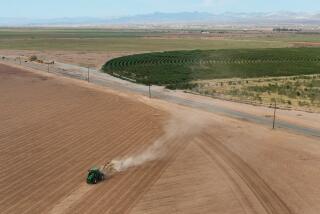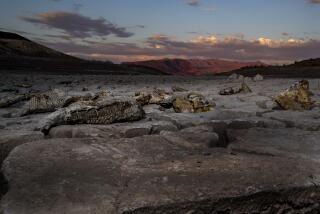No Relief From Drought, U.S. Experts Say : Forecast Increases Fear of Severe Loss of Crops, Particularly Wheat
- Share via
WASHINGTON — Government weather-watchers said Wednesday that they see no major relief in sight this summer from the drought conditions plaguing the nation’s Farm Belt, suggesting that crop damage ultimately may be as severe as some forecasters have said they fear.
In a series of forecasts covering the next 90 days, weather experts at the National Oceanic and Atmospheric Administration said that, with only minor exceptions, they expect the current hot and dry weather in drought-plagued states to continue through the remainder of the summer.
They said that the most likely change, if any, is that drought conditions might intensify in the Southeast. And they said that water levels in drought-hit rivers, such as the upper Mississippi, will almost certainly drop further.
Heightens Apprehension
The pessimistic prognosis appears to heighten apprehension that crop damage could be severe this year, particularly in wheat-growing states. Agriculture specialists have warned that the spring wheat crop in the upper Midwest must get rain by mid-July to escape serious loss in crop production.
“It’s just not a drought-breaking kind of forecast,” conceded Donald L. Gilman, chief forecaster of the atmospheric agency’s National Meteorologists Center. He said that the worst of the drought conditions over the next few weeks will continue to be centered in the Ohio Valley.
Ironically, the forecasts were made public as a cold front that moved into the Farm Belt late Tuesday dumped heavy but scattered rains totaling 1 to 4 inches on parts of seven Midwestern states.
Nevertheless, local forecasters in the Farm Belt cautioned that, despite Wednesday’s downpour, the danger to crops is far from over.
“This is not a drought-breaker,” National Weather Service forecaster Bob Collins said in Chicago. “We need another six to seven occurrences. We’re pretty far behind. It’s just a nice little light rain, and we could use a heck of a lot more like it.”
Prices Paid to Farmers Up
Meanwhile, the Agriculture Department reported that prices paid to farmers for grain and other crops rose 3.7% in June, partly because of the prospect that the drought would slash production of soybeans and grain.
In a preliminary report, the department’s Agricultural Statistics Board cited higher prices for soybeans, corn and wheat as the major factors behind the rise. The increases were partly offset by lower prices for cattle and peaches.
The June index left farm prices 6.9% above their level of a year ago. Soybean prices were at their highest since May of 1977. Prices of feed grains and hay, used in feeding livestock, also rose sharply.
At the same time, Congress continued to push toward enactment of legislation to protect farmers from financial losses. A group of senators led by Sen. John Melcher (D-Mont.) announced a proposal designed to channel relief money to farmers under a variety of existing programs.
Nevertheless, both houses are expected to move cautiously in passing legislation that would aid farmers. Senate Agriculture Committee Chairman Patrick J. Leahy (D-Vt.) has indicated that he will wait until mid-July before pushing through new legislation, saying that he wants firm damage reports before acting.
For all the pessimism in their medium-term weather forecasts Wednesday, National Oceanic and Atmospheric Administration officials stressed that the predictions are unusually uncertain and amount to little more than a coin-toss. “We’re just interpreting the odds in a particular direction,” Gilman said.
Agency officials were also cautious about assertions by some private scientists that the drought is related to the so-called “greenhouse effect,” the global warming trend brought on by increased carbon monoxide in the atmosphere caused by automobiles and other fuel-burning machinery.
Global Warming Discounted
William A. Sprigg, director of the agency’s Climate Office, told reporters that global warming may be making the weather more variable from year to year, but he said that there is no evidence yet that it is actually responsible for the dearth of rain that has plagued the farm states.
“We just don’t know why it’s happening,” he said of the drought.
In an accompanying report, the agency said that the two decades ending in 1987 had been the nation’s “wettest 20-year period of the 20th Century.” It said that eight of the 20 years had yielded above-normal levels of rainfall and 11 others had produced normal amounts.
More to Read
Sign up for Essential California
The most important California stories and recommendations in your inbox every morning.
You may occasionally receive promotional content from the Los Angeles Times.










